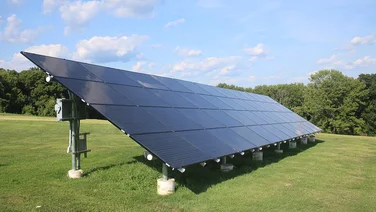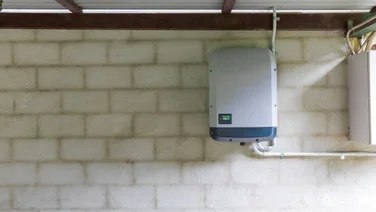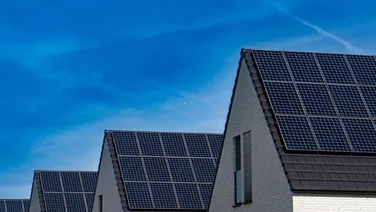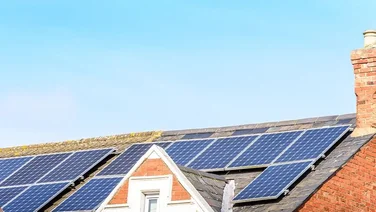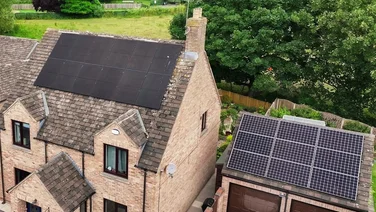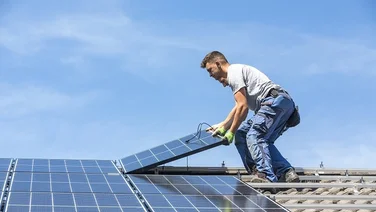- A District Network Operator (DNO) manages the electricity distribution network in your area.
- They ensure the infrastructure safely delivers electricity to homes and businesses.
- DNOs must approve solar panel systems over 3.68kWp to maintain grid stability.

When you plan to have solar panels installed, there’s lots to consider. Which installer should you use? How many panels should you go for? Will solar panels add value to your property?
However, an often overlooked aspect is that, depending on the installation size, you may need to complete a District Network Operator (DNO) application. Not all solar panel projects need to apply to installation; however, if your solar PV system exceeds 3.68kWp of capacity, you’ll need permission from the relevant DNO.
While this may sound daunting, don’t worry as we’ve created this handy guide that contains everything you need to know about DNO applications. We’ll hold your hand though figuring out if you’ll need one to a step-by-step approach to completing one.
Your solar panel installer should be able to guide you through the process, so it’s key that you find a good and trustworthy one.
If you want to know how much it’ll cost to install solar panels, simply enter a few details in our short form. Our expert installers make it easy by getting back to you with bespoke quotes.
What is a District Network Operator and why is it important?
A DNO is the electricity distributor providing power to your home. They are responsible for maintaining the electricity power lines, both underground and overhead.
Unlike energy suppliers such as EDF or OVO Energy, DNOs manage the network infrastructure and deliver electricity to homes. The UK is split into 18 district networks covering large geographic regions, each managed by a DNO.
Some DNOs manage multiple networks, and six operate across the UK. Examples of DNOs in the UK include Northern Ireland Electricity, UK Power Networks, and Western Power Distribution.
To find out who your local DNO is, complete the Energy Network Association’s postcode checker.
If you have installed solar panels on your home and they are generating electricity, you need to let your regional DNO know. The size of your solar installation (above or below 3.68kWp) determines whether you need to make a DNO application before any work is carried out.
This is because the DNO has to monitor fluctuations in the electricity grid. Any overload in the local grid can cause issues, even so far as tripping out the network.
DNOs must be notified of your solar panels via an application as they are responsible for maintaining the grid’s infrastructure. Your solar installer will usually be able to advise you and take care of your application.
Also, if you don’t complete a DNO application, you won’t be eligible for Smart Export Guarantee (SEG) payments for the excess energy your solar panels may produce, which can be sold directly to an electricity supplier.
Do I have to apply for a DNO before installing solar panels?
According to government guidance, you must inform your local DNO if you intend to install an energy device on your property, including solar PV, that connects to the local electricity grid.
If your solar scheme is larger than 3.68kWp, the only way you can avoid requiring a DNO application is if you intend to keep your solar energy off-grid, meaning it connects directly to your property only and not to the UK’s electricity system. But people rarely choose this route due to the huge costs involved, not to mention a lack of electricity supply in the winter!
There are two types of applications, G98 and G99, depending on the size of the solar panels installed. As expected, larger systems require more application paperwork than smaller installations.
You will also need a DNO application to install a solar battery storage system alongside your solar PV. The process is the same as for solar panels as outlined above, and your installer can guide you through it again.
How to complete your DNO application
The great news is that your solar installer can manage the DNO application for you. A few steps are needed to ensure the application process goes smoothly.
- Step 1 – Ensure your solar installer is appropriately certified
Firstly, it’s important to ensure you engage a solar panel installer registered with an appropriate certification scheme.
Check if the installer you wish to use is registered with a Competent Persons Scheme or through a certified body such as the Microgeneration Certification Scheme (MCS). Registering with such a scheme is voluntary for installers and allows them to self-certify that their work complies with national building regulations.
Always ask for proof of certification before agreeing to any work to be carried out on your property.
- Step 2 – Identify whether the DNO application should be submitted BEFORE or AFTER installation
Once you’ve got a certified contractor to install your solar PV, they can advise whether you need to notify the DNO before or after the panels are in place.
‘Connect and notify’ means the DNO application can be completed after installation. This involves completing a G98 application form within 28 days of the solar panels being in place. It is for smaller solar PV systems that are under 3.68kWp in size.
‘Apply to connect’ is for larger installations exceeding 3.68kWp and requires a G99 application. The DNO must check whether the grid can take the extra electricity load before your system is up and running.
If you submit an ‘apply to connect’ DNO application, it can take up to 11 weeks for your approval to come through, so plan not to hold up your solar installation.
- Step 3 – Install the solar PV and make sure the installation is registered
Once the solar panels are in place, your installer must notify either their competent person scheme or other certification schemes.
As the device owner, you are responsible for ensuring that your installer has notified the relevant DNO of the solar PV installation being complete – and if it was an ‘apply to connect’ project, it was granted authorisation before the work was carried out.
- Step 4 – Wait for your documentation to come through
Your installer will be able to provide the necessary documentation for your solar PV system, including:
- Building Regulations Completion Certificate – you’ll need this if you ever sell your property.
- Installation certificate (provided directly by the installer)
- Step 5 – Apply to the Smart Export Guarantee (SEG) Scheme
Anyone with a solar PV installation of up to 5MW (megawatts) in Britain can apply to the SEG scheme, allowing them to receive payments for electricity they export to the grid. Ofgem provides advice on how to join the scheme.

Can a DNO application be rejected?
In some cases, applications can require further action if the local grid network can’t take the excess energy your solar panels produce.
This could involve the DNO putting a cap on the amount of energy you can export, which would involve installing an export management system and paying a small fee for this to be accepted by the DNO.
Otherwise, if the local electricity infrastructure requires upgrades to take excess energy, there could be a large cost involved with facilitating grid upgrades.
Next steps
Before installing solar panels on your property, finding a decent, certified installer who can guide you through the DNO application process is essential.
There’s not much point in installing solar panels on your home if they can’t be connected to the local electricity network! Use our online form to start the process and receive a free quote for solar panels.
Want to get a head start on your solar panel project? Find out how much it’ll cost to install solar panels by entering a few details in our short form. Our expert installers will then get in touch with free bespoke quotes.
Summary
- Start your solar journey today with certified experts who simplify the process.
- Ensure your solar installer is certified and experienced to handle your DNO application.
- DNO approval is essential for connecting larger solar systems to the electricity grid.
- Completing the DNO process ensures compliance and eligibility for SEG payments.
- Work closely with your installer to avoid delays or complications with your solar project.


